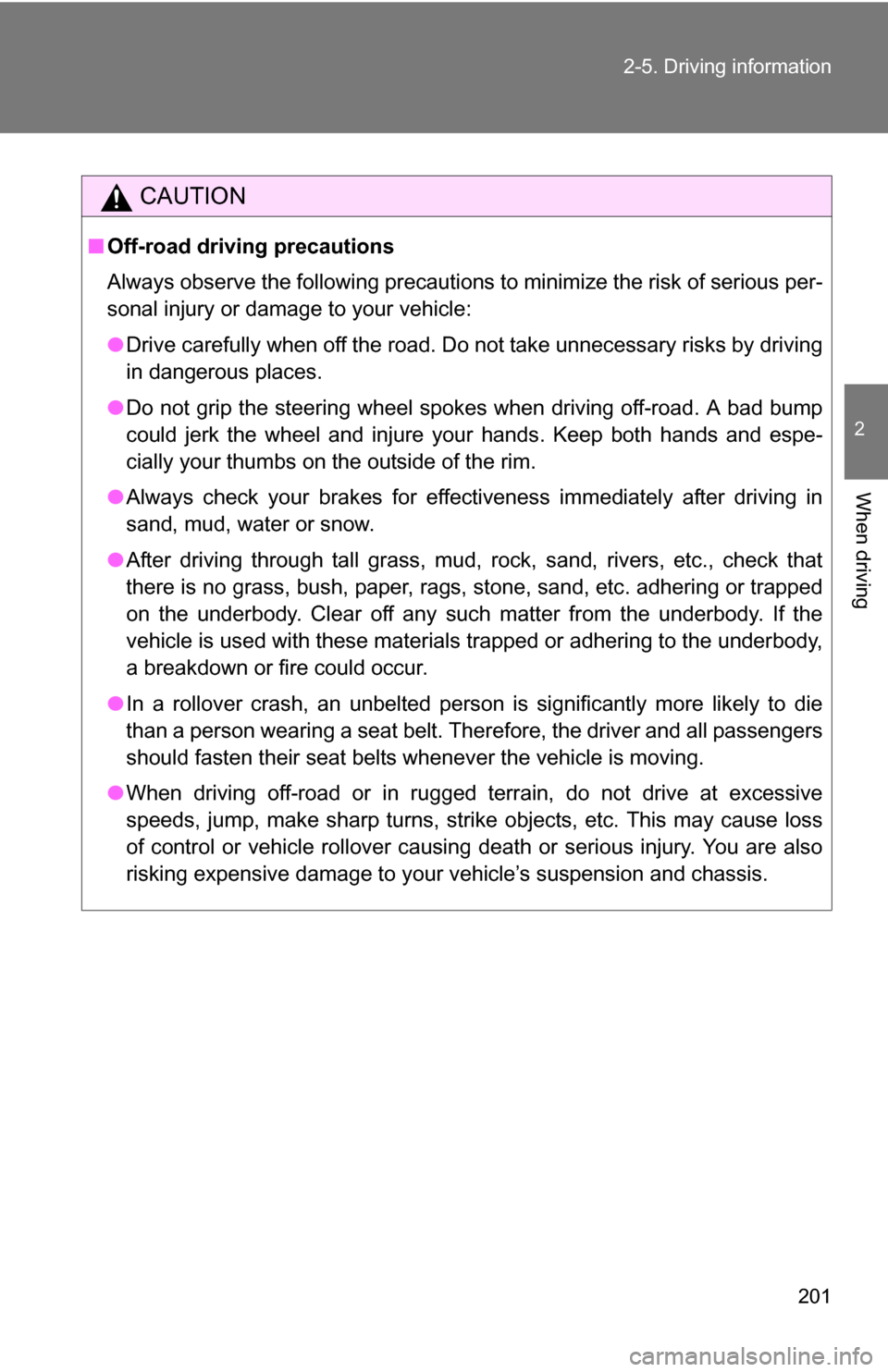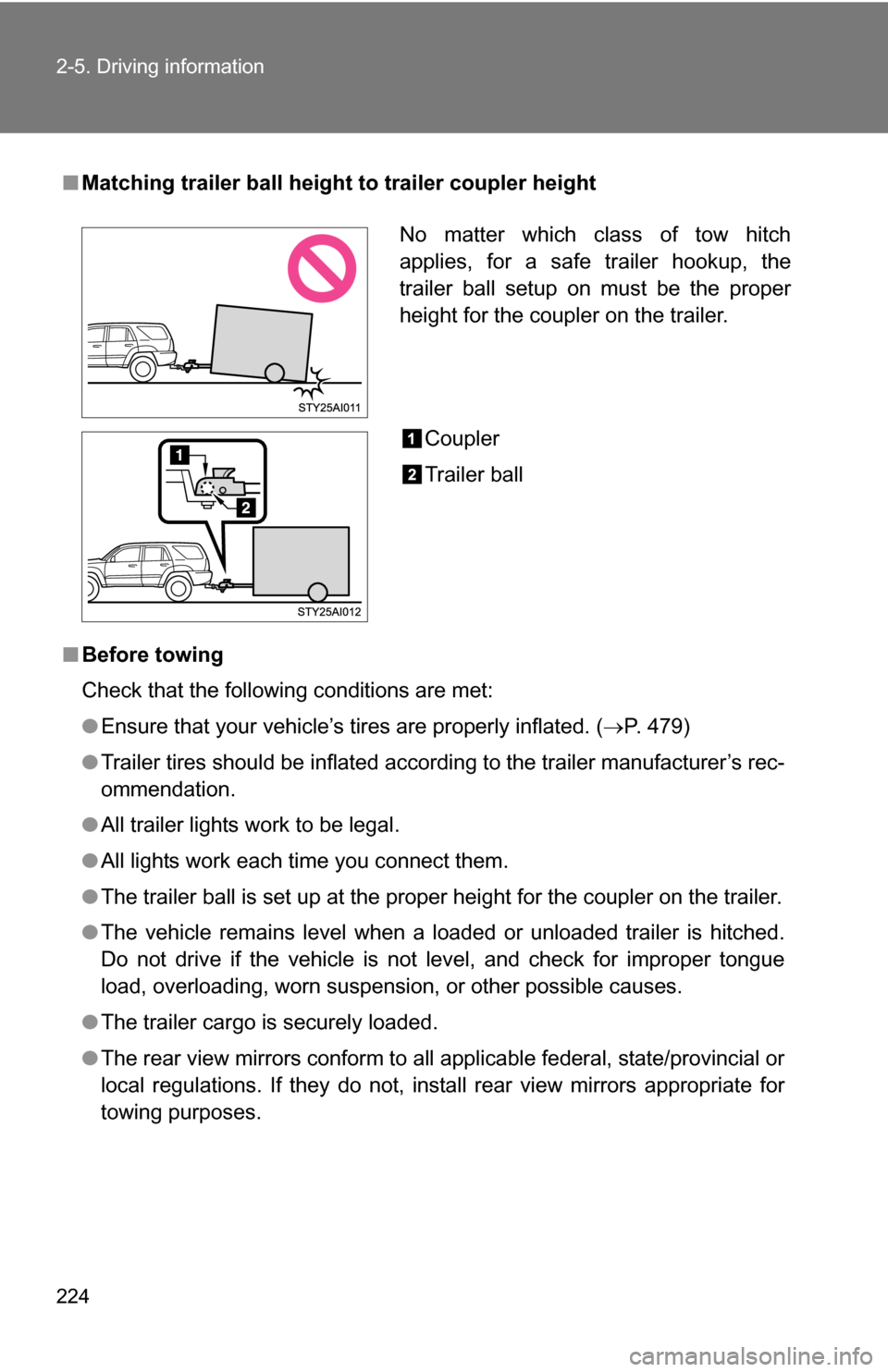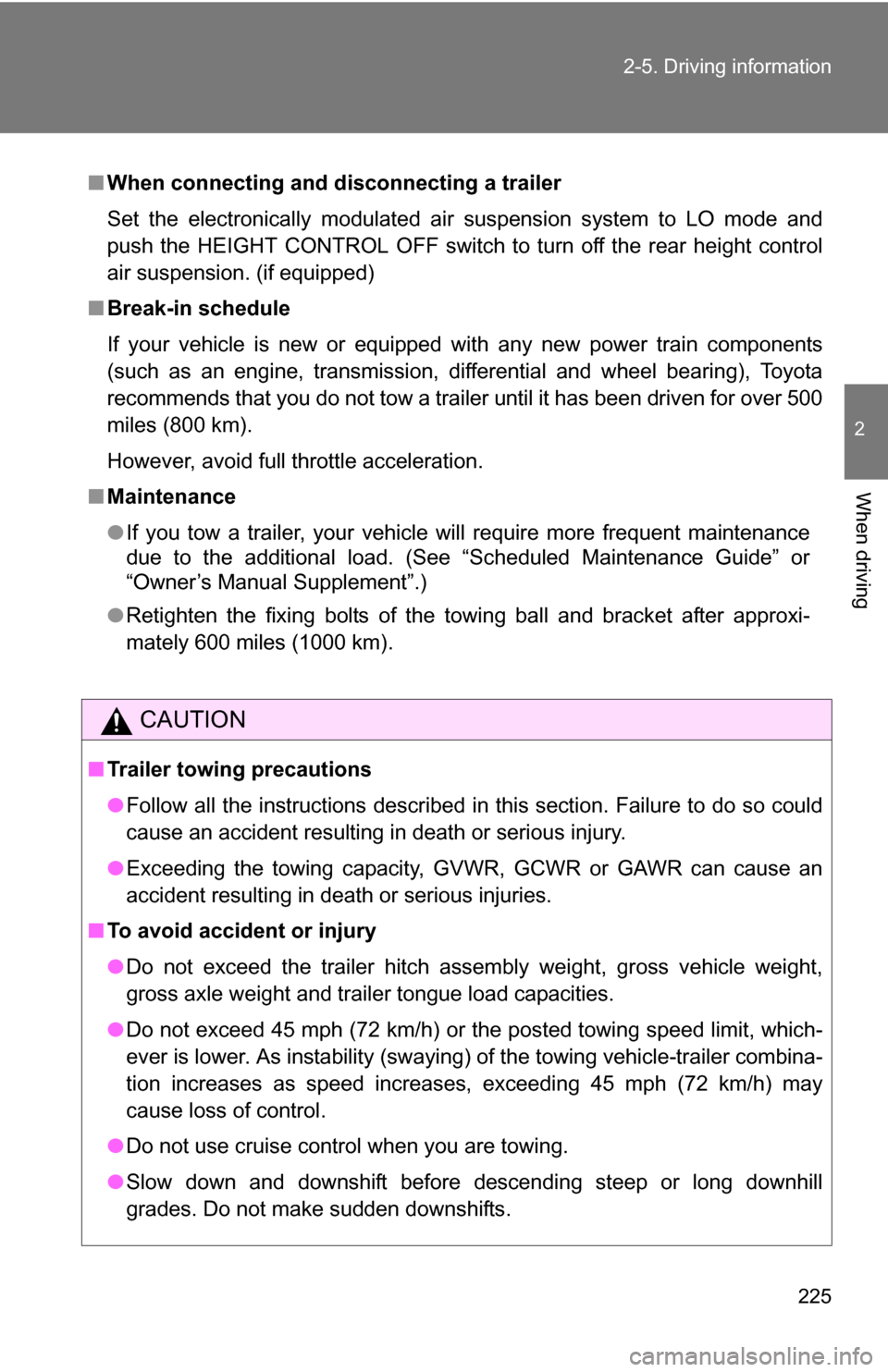Page 199 of 520

199
2-5. Driving information
2
When driving
CAUTION
■
Off-road vehicle precautions
Always observe the following precautions to minimize the risk of serious per-
sonal injury or damage to your vehicle:
●In a rollover crash, an unbelted person is significantly more likely to die
than a person wearing a seat belt. Therefore, the driver and all passengers
should fasten their seat belts whenever the vehicle is moving.
● Avoid sharp turns or abrupt maneuvers, if at all possible.
Failure to operate this vehicle correctly may result in loss of control or
vehicle rollover causing death or serious injury.
● Loading cargo on the roof luggage carrier will make the center of the vehi-
cle gravity higher. Avoid high speeds, sudden starts, sharp turns, sudden
braking or abrupt maneuvers, otherwise it may result in loss of control or
vehicle rollover due to failure to operate this vehicle correctly.
● Always slow down in gusty crosswi nds. Because of its profile and higher
center of gravity, your vehicle is more sensitive to side winds than an ordi-
nary passenger car. Slowing down will allow you to have better control.
● When driving off-road or in rugged terrain, do not drive at excessive
speeds, jump, make sharp turns, strike objects, etc. This may cause loss
of control or vehicle rollover causing death or serious injury. You are also
risking expensive damage to your vehicle’s suspension and chassis.
● Do not drive horizontally across steep slopes. Driving straight up or
straight down is preferred. Your vehicle (or any similar off-road vehicle)
can tip over sideways much more easily than forward or backward.
Page 201 of 520

201
2-5. Driving information
2
When driving
CAUTION
■
Off-road driving precautions
Always observe the following precautions to minimize the risk of serious per-
sonal injury or damage to your vehicle:
●Drive carefully when off the road. Do not take unnecessary risks by driving
in dangerous places.
● Do not grip the steering wheel spokes when driving off-road. A bad bump
could jerk the wheel and injure your hands. Keep both hands and espe-
cially your thumbs on the outside of the rim.
● Always check your brakes for effectiveness immediately after driving in
sand, mud, water or snow.
● After driving through tall grass, mud, rock, sand, rivers, etc., check that
there is no grass, bush, paper, rags, stone, sand, etc. adhering or trapped
on the underbody. Clear off any such matter from the underbody. If the
vehicle is used with these materials trapped or adhering to the underbody,
a breakdown or fire could occur.
● In a rollover crash, an unbelted person is significantly more likely to die
than a person wearing a seat belt. Therefore, the driver and all passengers
should fasten their seat belts whenever the vehicle is moving.
● When driving off-road or in rugged terrain, do not drive at excessive
speeds, jump, make sharp turns, strike objects, etc. This may cause loss
of control or vehicle rollover causing death or serious injury. You are also
risking expensive damage to your vehicle’s suspension and chassis.
Page 224 of 520

224 2-5. Driving information
■Matching trailer ball height to trailer coupler height
■ Before towing
Check that the following conditions are met:
●Ensure that your vehicle’s tires are properly inflated. ( P. 479)
● Trailer tires should be inflated according to the trailer manufacturer’s rec-
ommendation.
● All trailer lights work to be legal.
● All lights work each time you connect them.
● The trailer ball is set up at the proper height for the coupler on the t\
railer.
● The vehicle remains level when a loaded or unloaded trailer is hitched.
Do not drive if the vehicle is not level, and check for improper tongue
load, overloading, worn suspension, or other possible causes.
● The trailer cargo is securely loaded.
● The rear view mirrors conform to all applicable federal, state/provincial or
local regulations. If they do not, install rear view mirrors appropriate for
towing purposes.
No matter which class of tow hitch
applies, for a safe trailer hookup, the
trailer ball setup on must be the proper
height for the coupler on the trailer.
Coupler
Trailer ball
Page 225 of 520

225
2-5. Driving information
2
When driving
■
When connecting and disconnecting a trailer
Set the electronically modulated air suspension system to LO mode and
push the HEIGHT CONTROL OFF switch to turn off the rear height control
air suspension. (if equipped)
■ Break-in schedule
If your vehicle is new or equipped with any new power train components
(such as an engine, transmission, differential and wheel bearing), Toyota
recommends that you do not tow a trailer until it has been driven for over 500
miles (800 km).
However, avoid full throttle acceleration.
■ Maintenance
●If you tow a trailer, your vehicle will require more frequent maintenance
due to the additional load. (See “Scheduled Maintenance Guide” or
“Owner’s Manual Supplement”.)
● Retighten the fixing bolts of the towing ball and bracket after approxi-
mately 600 miles (1000 km).
CAUTION
■Trailer towing precautions
●Follow all the instructions described in this section. Failure to do so could
cause an accident resulting in death or serious injury.
● Exceeding the towing capacity, GVWR, GCWR or GAWR can cause an
accident resulting in death or serious injuries.
■ To avoid accident or injury
●Do not exceed the trailer hitch assembly weight, gross vehicle weight,
gross axle weight and trailer tongue load capacities.
● Do not exceed 45 mph (72 km/h) or the posted towing speed limit, which-
ever is lower. As instability (swaying) of the towing vehicle-trailer combina-
tion increases as speed increases, exceeding 45 mph (72 km/h) may
cause loss of control.
● Do not use cruise control when you are towing.
● Slow down and downshift before descending steep or long downhill
grades. Do not make sudden downshifts.
Page 357 of 520

357
4-1. Maintenance and care
4
Maintenance and care
■
Rear height control air suspension (if equipped)
Do not spray a jet of high-pressure water at the air suspension unit, espe-
cially the air spring, at an extremely close range. This may damage the air
suspension.
■ Coating of rain clearing mirrors
To maintain the rain clearing ability, observe the following instructions.
●Clean the mirror with car shampoo or glass cleaner that does not contain
any silicon or abrasive, and then rinse it throughly with water.
● Expose the mirror to the sunlight 1 or 2 days.
■ To prevent deteriorati on and body corrosion
● Wash the vehicle immediately in the following cases:
• After driving near the sea coast
• After driving on salted roads
• If you see coal tar or tree sap on the paint surface
• If you see dead insects or insect droppings on the paint
• After driving in an area contaminated with soot, oily smoke, mine dust,
iron powder or chemical substances
• If the vehicle becomes heavily soiled in dust or mud
• If liquids such as benzene and gasoline are spilled on the paint surface
● If the paint is chipped or scratched, have it repaired immediately.
CAUTION
■Caution about the exhaust pipe
Exhaust gasses cause the exhaust pipe to become quite hot.
When washing the vehicle, be careful not to touch the pipe until it has cooled
sufficiently, as touching a hot exhaust pipe can cause burns.
Page 407 of 520
407
4-3. Do-it-yourself maintenance
4
Maintenance and care
Fuse layout and amperage ratings
■ Engine compartment
FuseAmpereCircuit
1 SPARE 10 A Spare fuse
2 SPARE 15 A Spare fuse
3 STOP 10 A Stop/tail lights, high mounted stop-
light, shift lock control system, anti-
lock brake system, traction control
system (2WD models), active trac-
tion control system (4WD models),
vehicle stability control system,
rear height control air suspension,
multiport fuel injection system/
sequential multiport fuel injection
system, trailer brake controller,
trailer lights (tail lights)
4 AC 115V INV 15 A AC inverter
5 FR FOG 15 A Front fog lights
6 OBD 7.5 A On-board diagnosis system
7 HEAD (LO RH) 10 A Right-hand headlight (low beam)
8 HEAD (LO LH) 10 A Left-hand headlight (low beam)
Page 408 of 520

408 4-3. Do-it-yourself maintenance
9 HEAD (HI RH) 10 A Right-hand headlight (high beam)
10 HEAD (HI LH) 10 A Left-hand headlight (high beam)
11 EFI NO.2 10 A Multiport fuel injection system/
sequential multiport fuel injection
system
12 HEATER NO.2 7.5 A Air conditioning system
13 AIRSUS NO.2 10 A Rear height control air suspension
14 SEAT HEATER 25 A Seat heaters
15 DEFOG 30 A Back window defogger, multiport
fuel injection system/sequential
multiport fuel infection system
16 MIR HEATER 10 A Outside rear view mirror heater
17 DOME 10 A Interior light, personal lights, wire-
less remote control system, door
courtesy lights, gauge and meter,
vanity lights, instrument panel
lights, running board lights, multi-
plex communication system
18 RADIO NO.1 20 A Audio system, navigation system,
rear seat entertainment system
19 ECU-B 10 A Anti-lock brake system, traction
control system (2WD models),
active traction control system (4WD
models), vehicle stability control
system, air conditioning system,
multiplex communication system,
theft deterrent system, driving posi-
tion memory system, front passen-
ger occupant classification system
20 ALT-S 7.5 A Charging system
21 HORN 10 A Horns
22 A/F HEATER 15 A A/F sensor
FuseAmpereCircuit
Page 409 of 520

409
4-3. Do-it-yourself maintenance
4
Maintenance and care
23 TRN-HAZ
15 ATurn signal lights, emergency
flashers
24 ETCS 10 AMultiport fuel injection system/
sequential multiport fuel injection
system
25 EFI 20 AMultiport fuel injection system/
sequential multiport fuel injection
system
26 DR/LCK 20 A Power door lock system
27 TOWING 30 A Towing converter
28 RADIO NO.2 20 A Audio system
29 A/PUMP 50 AMultiport fuel injection system/
sequential multiport fuel injection
system
30 AIRSUS 50 A Rear height control air suspension
31 AM1 50 AACC, CIG, IG1, ECU-IG, FR WIP-
WSH, RR-WSH, 4WD, and STA
fuses
32 TOWING BRK 30 A Trailer brake controller
33 J/B 50 APWR OUTLET, D P/SEAT, P P/
SEAT, POWER, TAIL, SECU/
HORN fuses
34 BATT CHG 30 A Trailer sub battery
35 TOWING 40 A Trailer lights (tail lights)
36 ABS MTR 40 AAnti-lock brake system, traction
control system (2WD models),
active traction control system (4WD
models), vehicle stability control
system
37 AM2 30 AStarter system, IGN, GAUGE,
STA NO.2, SRS fuses
FuseAmpereCircuit